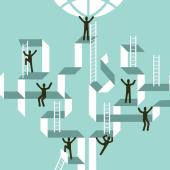We Have Failure All Wrong
The Word On The Street
In the world of corporate innovation, we hear the word ‘failure’ bandied about a lot... with phrases like:
- “If we’re not failing often, then we’re not trying hard enough.”
- “We need to tolerate failure – even celebrate failure – so that we can find the real winners.”
- “People need the psychological safety to know they can try new things and fail at them – and all will be okay.”
And on the litany goes.
But there is a very fundamental error in this thinking – one that gets at our very understanding of what a ‘failure’ is and is not.
The Problem
The problem here lies not in the ‘new things’ our people are trying out, or the fact that they’re trying out new things, but rather in our own underlying – and typically unstated – assumption about their efforts in these areas.
That underlying, unstated assumption is that we consider every such effort a ‘project’, and the default expectation of all projects is ‘success’. It’s ingrained in us… it’s the way operations works inside of business… its what we’re taught the goal of all ‘projects’ is – that of course they’re going to succeed; that’s the whole point of doing a project in the first place – to succeed at its aims. Otherwise why even do the project. Success is the only acceptable outcome.
But that is fundamentally erroneous thinking. It is a fundamentally wrong way of looking at the ‘new things’ our people are trying.
The Root Cause – Our Own Arrogance
Whether we like to admit it or not, the root cause of this sort of thinking lies in our own human arrogance and cognitive bias. It’s called survivor bias (one of hundreds of such cognitive biases stemming out of the human ego), and it would have us to believe that, no matter what, we will prevail; we will succeed; we will win – even when others before us have not.
It’s why every army marches headlong into war – sometimes even without counting the cost.
And its why every business leader has the de facto assumption that their people will of course succeed at whatever endeavor they undertake – it’s what we do in business – we succeed at efforts so we can reap the benefits of those efforts. People who don’t succeed at their efforts – well they must be losers; something must be inherently wrong or flawed about them – and of course we’ll never ever promote them into a position of leadership; to do so would be heresy.
That was, at least, the Twentieth Century industrial era mindset – much of which still prevails in the business world today.
But it is not the Twenty-First Century entrepreneurial-era mindset that today demands. Today, we must change the game.
Stopping The Madness
As we noted before, the problem here lies in our own underlying - and typically unstated - assumption about the ‘new things’ our people are trying out.
We inherently see those new things as being ‘done deals’… ‘sure things’… ‘slam dunks’. Otherwise why are our people even wasting their time trying them?
We must stop seeing them that way! We must put to death that fundamentally erroneous assumption about people’s efforts at ‘new things’.
The New Game
If we must put to death that former inerrant assumption, then what shall we replace it with?
We start by going back to first principles, and we replace it with a fundamentally new assumption about trying new things.
That new assumption builds on the following seven (7) precepts:
- All business efforts – when they first began back in their infancy (even the ones we're promulgating today) – were built on some set of assumptions. Over time we figured out which of those assumptions were correct (those became ‘fact’), and which weren’t (those became ‘fallacy’).
- The assumptions on which those lines of business were built will become less and less factual over time.
This is inevitable given how rapidly and incessantly our world continues to change. - The future is inherently and fundamentally unknown – no matter how good we may be at strategic foresight.
- We cannot know with any certainty which new things will succeed and which will not succeed in that unknown future.
- But we do know that what we’re doing today has an inherently limited lifespan to it – the clock is ticking down toward its eventual demise – not unlike our own mortality.
- Consequently, we must have new things for the future to replace these present things. And so we must be working today to figure out what those new things need to be.
- Consequently, we have to experiment – and do so relentlessly – in order to discover what those successful new things are going to be in the future.
And so – and here is the climax of this new perspective – we have to start seeing every effort toward a new unknown ‘thing’ in the following ways:
- The assumptions these efforts are built on (and all business efforts are built on some assumptions) are simply and merely that – assumptions. They are not fact. Indeed, if the future is, as we’ve stated, unknown, then they cannot be fact.
- Consequently, we can longer afford to treat those assumptions as though they were facts – the way we always have.
- Instead, we must see them as being hypotheses about the future… theoretical assumptions about what ‘might work’ in the future; not given facts about what ‘will definitely work’ in the future.
- Consequently, we can no longer view the ‘new things’ that our people are trying out as being inherently ‘done deals’; they are not. Instead, we have to see them as being business experiments designed to test those assumptions… to figure out which assumptions (hypotheses) are correct and which are not, and in both cases to what extent.
When we stop seeing our people’s efforts toward new things as being ‘projects inherently assumed to succeed’ and instead start seeing them as ‘business experiments designed to learn something useful’, then guess what will happen?
Hopefully you guessed the right answer this question. It is this: we will never again fail.
That’s right – you will never again fail. What you will instead do is prove certain hypotheses – certain assumptions – as being erroneous and incorrect. And that is a far different beast than a ‘failure’.
So our people don’t set out on new things to ‘succeed’ in the traditional sense; rather they set out on those new things to learn.
Learning Versus Earning
And so there is an appropriate way to frame this. It is by understanding that there are two types of efforts inside a business – those that exist for ‘earning’ and those that exist for ‘learning’.
Our established lines of business – whose fundamental assumptions have been proven to be true and factual (at least for the time being) – exist for ‘earning’. They must generate the revenues and profits we need, as they are what are pays our bills today – including the funds we need to fund our investments in figuring out tomorrow.
The ‘new things’ we are trying out are very different however. They exist (at least initially) for ‘learning’ – more so than for ‘earning’. And while we may in fact generate some revenue and possibly even some profit from them, that is not their primary purpose. Their primary purpose is to generate learning – to allow us to test out the hypotheses before us and figure out which of them are right and which are wrong. This allows us to figure out which ‘new things’ will ultimately be able to succeed and scale in the future, and which will not. We can then – once we understand those things – go on to perfect real lines of business around the correct hypotheses and scale those up into successful new lines of business for the future. But their fundamental purpose at the beginning is to learn, not to earn. If ever we forget this, then we’re right back to the Twentieth Century way of thinking that will ultimately lead to our demise.
A key thing to understand here is that organizations must be doing both of these things constantly and incessantly. They must be both earning and learning all the time. This is why the ambidextrous organization is so crucially important!
Are There Real Failures Then?
Are there ever real failures then? Yes there are.
A real failure occurs when we allow ourselves to march headlong into the future with some set of assumptions that we’ve never bothered to test for validity.
Indeed, if we let ourselves, and our people, go all the way from concept to commercialization without ever bothering to test the fundamental, underlying assumptions of that proposition along the way – and the end result of that is in fact business failure – then we have in fact truly failed.
But it isn’t the project itself that has failed – its execution was most likely flawless. What we’ve failed at is testing its underlying assumptions. That is where the failure lies – not in the execution of the project. Its underlying assumptions were, in fact, entirely wrong and invalid to start with. But we never bothered to test them. That is where a true failure lies.
A classical case in point of this was the original Segway personal mobility device. Billions of dollars were poured into its development, largely around cracking a technological problem known as ‘the inverted pendulum’ problem. And the hype for it was monumental – it was going to "transform urban mobility in a way never before seen by humankind." But that was all an assumption… a hypotheses, and one that was never truly tested by its conceivers. In the end that assumption turned out to be entirely wrong, causing its investors to lose those billions of dollars.
Step-Wise Learning
The correct approach therefore has to be a stepwise learning process – not unlike what Eric Ries called ‘validated learning cycles’ in The Lean Startup.
What this looks like is that we start with some, usually very broad, set of assumptions; we then design certain business experiments by which to test those assumptions; we then run those experiments to test the assumptions; we then analyze the findings and outcomes of those experiments and draw conclusions about the validity and/or invalidity of our assumptions (hypotheses) from that.
Doing this for one cycle lets us learn enough to know if we should stop at that point (our assumptions / hypotheses were so far off base that there’s no point in proceeding any further with them – at least at this point in time), or if we should take our new insights, refine our hypotheses from them, and then run yet another round of experiments to test this narrower, more refined set of assumptions.
We repeat this cycle, as needed, for several rounds – learning and refining our hypotheses (narrowing our assumptions) at each round – until eventually we reach a point as a group where we have adequate confidence in those assumptions that moving forward with a real, formal project is now warranted and justified. This is very much a Bayesian process, where we start at some starting point (however erroneous), and then work from there to converge toward a more correct point.
Some organizations call this process ‘Series A, Series B, Series C’, and so on – not unlike what one has with subsequent rounds of venture capital funding. This is because with each round they will typically invest an increasing amount of capital and resources into running its tests, such as, for example, investing in a large market, user, or design research effort in Series C to understand customer segmentation and psychographics at a far higher level of granularity.
The important thing to understand is that, throughout this process, never once is a commitment made to going forward all the way to full-scale launch, until after we – as a whole – have reached that decision milestone where everyone agrees that the evidence indicates doing so is a valid and justified business decision.
That is the purpose of repeated learning cycles – to refine and fine-tune our hypotheses until they are in fact correct. We can then build a real business on top of that. And then – and only then – are we justified in expecting actual ‘success’!
Intelligent Innovation
This is an intelligent approach to innovation – recognizing our assumptions for what they are – theoretical until proven otherwise – and then going through an intelligent and thoughtful process of testing those assumptions and discovering which are valid and which are not – long before we ever invest large sums of capital and resources into those efforts.
The better we can become at this, the far more success we will have at new innovation.
And – most importantly – we will never again have a failure.
Even better yet – when we see our efforts through this lens, now all of a sudden we don’t have to try nearly so hard to create:
- a culture of innovation and relevance;
- an environment that nurtures innovation and experimentation;
- the psychological safety needed to try out new things.
All of these things just naturally occur as a byproduct of this practice.
But the one thing to keep in mind is that not only do we have to ingrain this approach of relentless experimentation into our collective organizational psyche, we have to make it a way of life – an inherent part of what we do each and every day of our working lives – day in and day out. We can never stop doing it.
Otherwise we’ll be right back at having ‘failures’.



